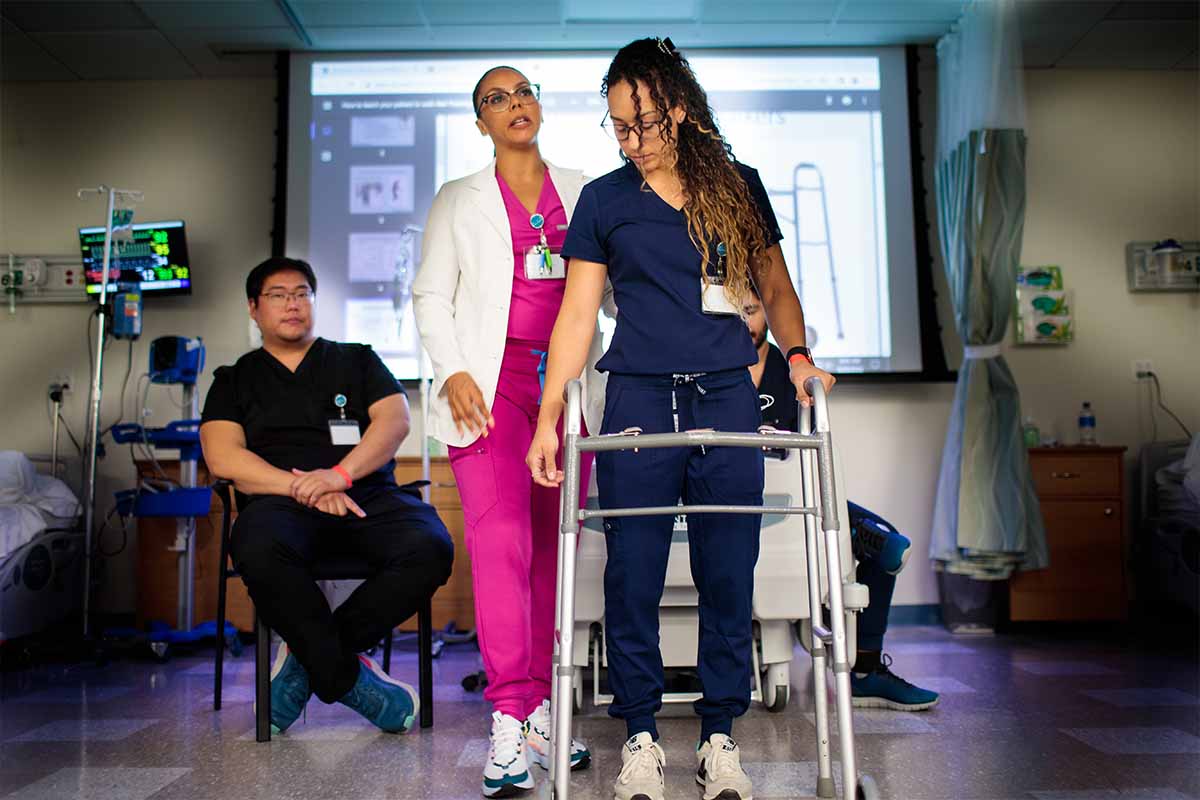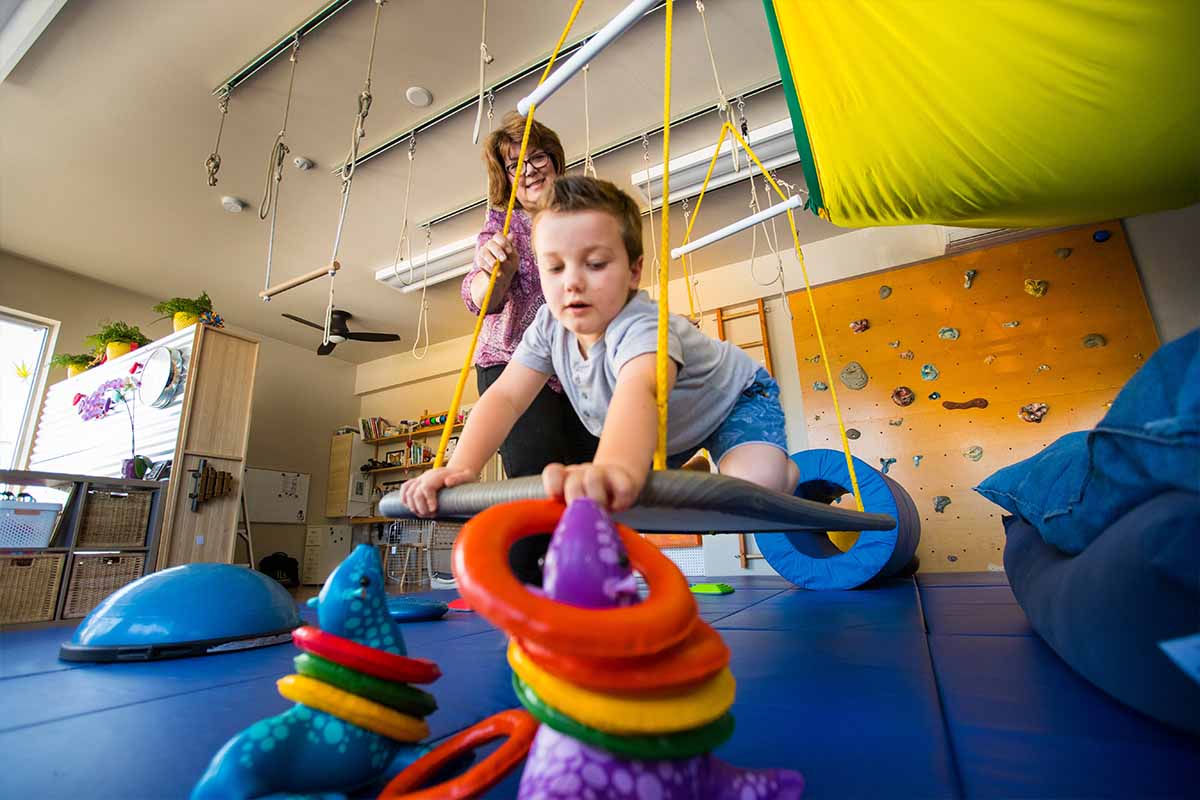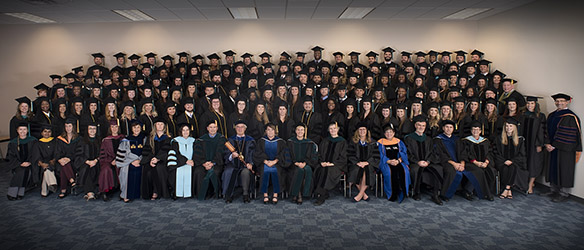
“I love creating a world where you’re free to make mistakes—and people won’t judge you or make fun of you,” says Christina Gonzalez, OTD ’21. She is helping to create this kind of world by facilitating virtual reality experiences for kids who have autism spectrum disorder (ASD). “Virtual reality is a controlled, consistent environment that some kids with ASD respond well to,” she says. “They can practice social skills in a safe and empowering way.”


Christina Gonzalez, OTD ‘21
For her capstone project in USAHS’ Doctor of Occupational Therapy (OTD) program, Dr. Gonzalez focused on the therapeutic use of virtual reality (VR) with children ages 12 to 14 who have ASD plus intellectual giftedness (ASD + IG). In collaboration with Jaclyn Wickham, MPS, a VR developer in New York, she wrote an intervention protocol that occupational therapists can use to guide their therapy sessions using VR with this population.
How VR Can Help Kids on the Spectrum Practice Social Skills
In the OTD program’s third-term Assistive Technology class, Dr. Gonzalez participated in an online seminar on virtual reality led by Wickham. Under the auspices of her company, Cyclometer, Wickham collaborates with OTs and other rehabilitation professionals to develop virtual reality–based learning modules for young people with ASD and other developmental disabilities. The modules are designed to help this population develop independent living skills, practice social skills, build safety awareness, and navigate challenging community locations.
“VR is almost like a rehearsal,” Wickham says. “They feel that they’re there.”
She notes that the use of 360-degree video differentiates AcclimateVR modules from other therapy-oriented VR offerings. Rather than using animation and avatars, Wickham’s team films live actors in real settings. Sensory stimulation is present (bright lights, ambient noise), but to a degree that is less overwhelming for students than real life. “It mimics the real experience and gives children a chance to practice challenging skills before they have to apply those skills in public.”


Wickham works with a child
The modules feature built-in assessments to check for understanding of the targeted skills. They are intended for use with a smartphone placed inside a cardboard viewer or any mobile VR headset, creating inexpensive VR goggles that are accessible to classrooms and easy to implement. On a separate device, the teacher or therapist can observe what the child is experiencing.
For example, one scenario takes place in a grocery store. “You” (as the person wearing the goggles) look at a grocery list, then navigate aisles to find and grab the items. You wait in the checkout line, then speak with the cashier and choose the right bill to pay with. Please see a video excerpt here.
“It’s practice for the real world in a safe setting where you can make mistakes,” says Dr. Gonzalez, adding that the “wow” factor of cool technology makes a VR session “way more motivating for kids than just regular therapy.”
Creating a Protocol for OTs


Jaclyn Wickham, MPS, founder of AcclimateVR
“When Christina contacted me about creating a protocol, it was perfect timing,” Wickham says. She had realized that therapists needed more guidance on how to best facilitate the process with children. “Virtual reality is a very new experience for these kids,” she says. “They’re not used to wearing a VR headset. You have to assess whether they’re a good candidate and determine that they won’t have negative sensory effects.”
Dr. Gonzalez’s intervention protocol guides the therapist (who might be an occupational therapist, physical therapist, speech-language pathologist, or other practitioner) through a session. It offers guidance around who makes a good candidate for VR, how to help the child acclimate to the headset, what to do if the child doesn’t respond well, how to support the child through the module, when to repeat skills, and more. Below is a diagram of Phase II of the four-phase protocol.


Phase II of the protocol
“Christina did an incredible job,” Wickham says. “She took so much of our feedback from usability testing and applied it in the protocol. It’s visually appealing, and it will be easy to hand over to a teacher or therapist.”
“There’s a lot that goes into a protocol,” Dr. Gonzalez says. “You have to make it narrow enough to be standardized and broad enough to apply to a range of situations.”
AcclimateVR’s Origin Story
A former elementary school teacher, Wickham cultivated an interest in Ed Tech and knew that teachers needed more tools. She enrolled in the Interactive Telecommunications Program (ITP) at New York University, which she describes as “a coding boot camp.” In a project for an assistive technology class, she collaborated with an OT who worked at the Manhattan Childrens Center, a school for kids with ASD. The OT would take students on field trips to public places, such as a grocery store, to practice social skills. But there were logistical complications, and even taking the subway to their destination was too overstimulating for some children. “We thought, ‘What if they could practice these skills in a safe, controlled environment?’” Wickham recalls. She created the grocery store module and launched AcclimateVR as her graduate thesis.
She went on to work in collaboration with OTs and students at Wildwood, a school for young people with ASD and other learning disabilities. Her team filmed a busy intersection so that the kids could practice crossing the street virtually before doing it in real life. She also partnered with Cooperative Educational Services in Connecticut to create a module about working as a barista in a café.
“It was engaging,” says Margaret Giordano, a Wildwood teacher who participated in the first round of usability tests. “One of my students, who is normally a chatterbox, was dead silent while using it… completely enraptured.”
Working with a Unique Population
Dr. Gonzalez chose to focus her project on kids with ASD + IG because their relative strengths in academics, creativity, and task commitment make them good candidates for VR—and they also can benefit from the chance to practice social communication and interaction through VR.
“This population is difficult to identify,” she says. “It’s small, overlooked, and lacking in resources. Clinicians often misdiagnose the child due to the camouflaging effect. This means that the child’s gifted characteristics often mask their disabilities, and their disabilities camouflage their talents.”
Taking the Protocol Forward
Throughout the project, Dr. Gonzalez had to adapt her goals and plans according to changing COVID-19 restrictions. She had hoped to visit New York and implement the protocol with Wickham and her clients. But she wasn’t able to travel, and AcclimateVR paused its filming activities because of the pandemic. But Wickham is looking to apply the protocol in future partnerships in 2022.
The final phase of Dr. Gonzalez’s protocol addresses practice in community settings: seeing whether the kids can transfer and generalize the skills learned in the VR environment to the real world. Wickham plans to gather data about this as a next step for AcclimateVR.
Virtual Reality at USAHS
Dr. Gonzalez also lent her talents to another virtual reality initiative: A pilot on USAHS’ St. Augustine campus. Using virtual reality, OT students can now experience their patients’ environments remotely to better understand their patients’ challenges. Wearing the VR goggles, students can look 360 degrees around a setting and use “grabbers” to pick up objects.
Dr. Gonzalez worked with faculty and staff during the proposal process, assisting with a literature search and envisioning how this initiative would work in the classroom. “Virtual reality offers great potential for more student engagement in education,” she says. “I love technology.”
The University of St. Augustine for Health Sciences (USAHS) offers hands-on Master of Occupational Therapy (MOT) and Doctor of Occupational Therapy (OTD) degrees. Join a collaborative cohort of peers who learn under the mentorship of expert faculty-practitioners. Practice with mock patients in our state-of-the-art simulation centers and learn anatomy with our high-tech tools. Prepare for clinical practice with patients across the lifespan. The OTD program includes a capstone project and additional coursework in practice leadership and policymaking. Residential (online coursework + in-person labs on weekdays) and Flex (online coursework + in-person labs on weekends) formats are available.








